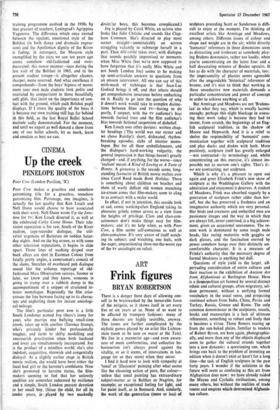The young idea
BALLET CLEMENT CRISP
The first glimpse we had at Golders Green of The Young Stars of the Bolshoi Ballet and the Bolshoi Ballet School' was dauntingly un- stellar : a gaggle of immature young students, vilely costumed, confined on a stage far too small and drearily draped, with the British Concert Orchestra in lacklustre attendance. Of the professional excitement promised by the title there was nary a trace, nor yet any choreographic interest in the version of Paquita (a spavined old war-horse) or the deadly Classi- cal Symphony which framed a collection of duets and trios. All in all, a dispiriting show by the immensely professional standards that we have been taught to expect from the Bolshoi.
But viewed on purely academic terms, as a display of current Soviet training, the evening becomes intensely interesting—and rewarding. How superb is the schooling these young dancers are given, how fine their basic skills which are destined to ripen and expand with professional experience. Beautiful placing, superb backs and arms, strong musical feeling, a control in use of legs and feet that avoids any strain or over-insistence on those grandly extravagant extensions that are developed later in the dancers' careers : at the present stage in their training these young artists con- centrate with modest decorum on walking before they run artistically. The result is a show for aficionados, for balletomanes, and for anyone interested in seeing superlative preparation for the most arduous and demand- ing of physical careers.
One thing is particularly significant: the young Bolshoi style is seemingly nearer the nobility and reserve of the Kirov school than ever before—thanks, we may suppose, to the
training programme evolved in the 1930s by that greatest of teachers, Leningrad's Agrippina Vaganova. The difference which once existed between the opulent, emotional style of the Bolshoi (in both dance and dramatic expres- sion) and the Apollonian dignity of the Kirov is fading; in retrospect, the Moscow style exemplified by the stars we saw ten years ago seems somehow old-fashioned and over- decorated; this newer manner—seen during the last visit of the Bolshoi in 1965, and in the present student troupe—is altogether cleaner, sharper, more reserved. And what excellence it comprehends—from the boys' bigness of move- ment (our own male students look polite and restricted by comparison) to those beautifully soft plids, that insist on the importance of con- tact with the ground, which each Bolshoi pupil displays. If I stress the quality of the boys it is because our own training still lags far behind in this field, as the last Royal Ballet School matinde sadly demonstrated. For the moment, and until we export as well danced a show from any of our ballet schools, let us mark, learn and emulate as best we can.



































 Previous page
Previous page